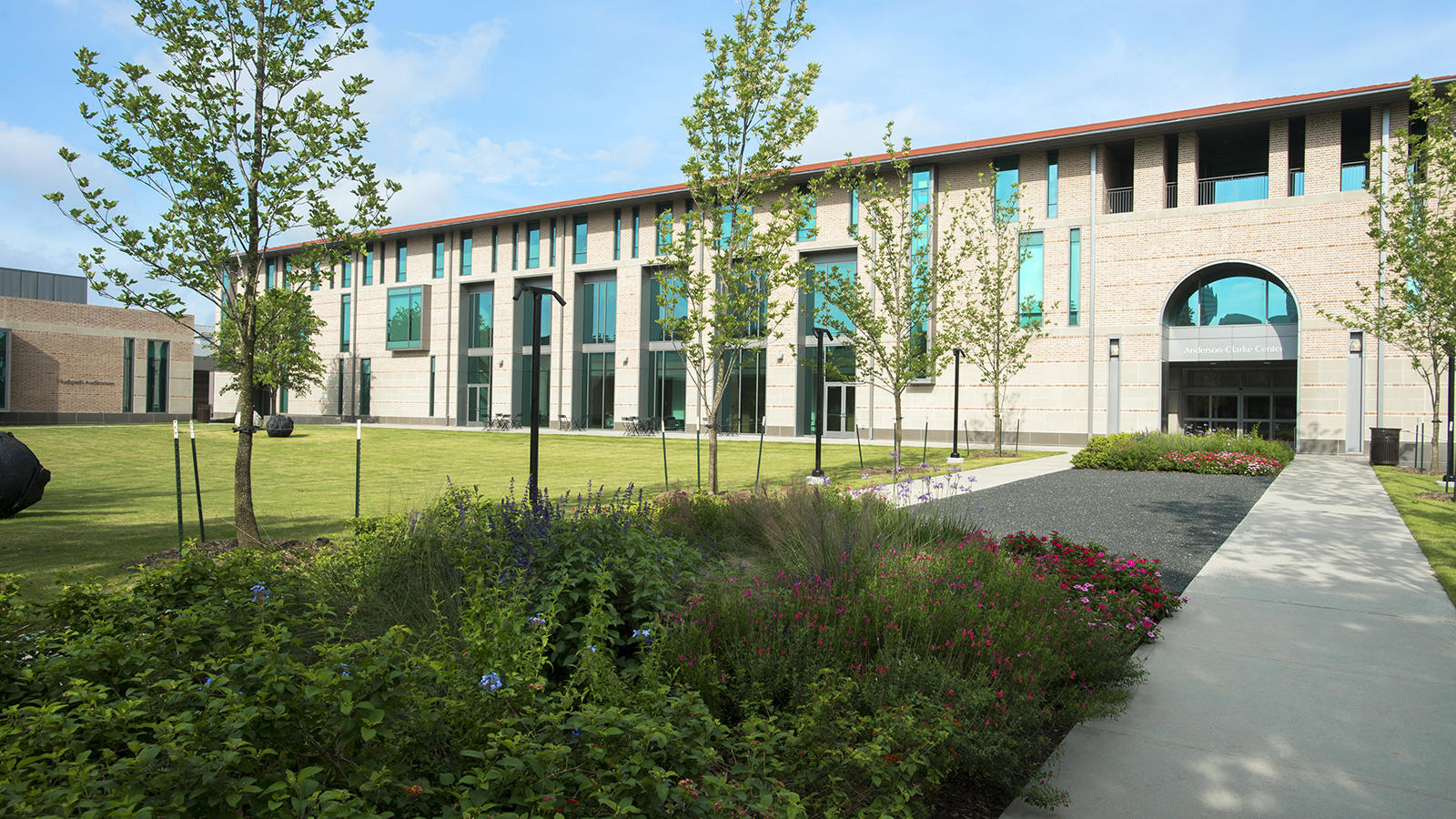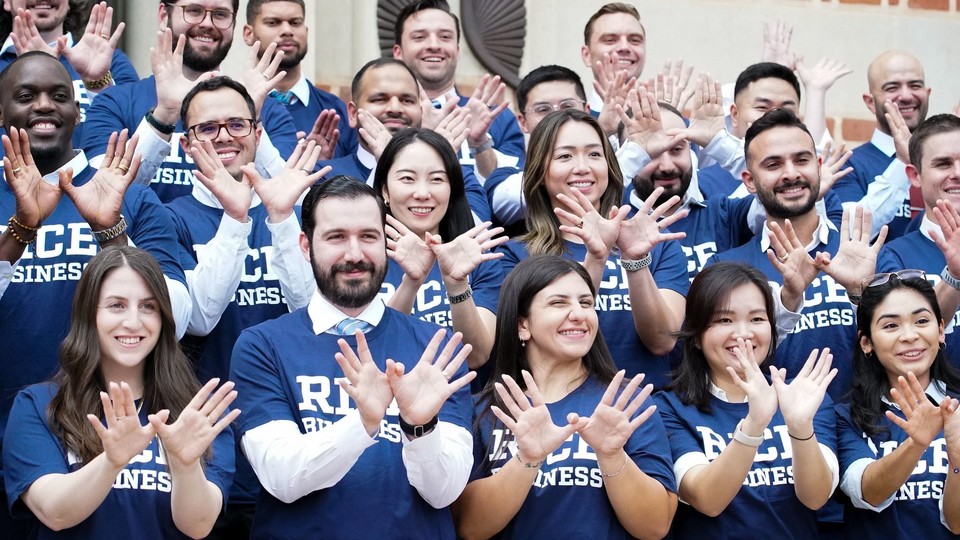Choose Houston
The 21st century business world demands constant new ideas and adaptability. That means the city where you go to business school is now a key part of your business education. Here's why you need a Houston MBA.


Updated from original post that was published on 9/4/2019.
Why Should You Get Your MBA In Houston?
The sight is quintessential Houston. Scrawled on the overpass over a teeming freeway, a set of giant handwritten letters urge all who pass through: BE SOMEONE.
Those two words also happen to be shorthand for why the culture of this port city has become an influential tool for serious students of business.
As the world economy depends more and more on new skills and ideas, where business students study is a key aspect of which school they choose. A Houston MBA degree – earned in the fourth largest city in the U.S., a magnet for entrepreneurs and gateway to a 21st century Silk Road – means access to a range of business experiences that may be unique in America.
Houston’s work-friendly culture is ideal for MBA degree holders.
First, Houston’s culture revolves around jobs. Large, small and nascent companies gravitate here for the city’s business-above-all environment. The most obvious lure is Texas’ lack of a state income tax, which allows companies more freedom to hire and invest in growth. Secondly, Houston is distinct in being the only major American city with no zoning laws. This policy, or rather lack of one, makes for the city’s signature landscape of tiny bungalows side-by-side with towering apartment buildings — and also creates fertile ground for businesses to sprout anywhere an entrepreneur’s imagination may roam.
The average cost of living in Houston is lower than that of other major U.S cities.
Third in Houston’s trifecta of business attractions: affordability. The average cost of living here is 24 percent below the average for the country’s 20 most-populated cities, the Council for Community and Economic Research reported in 2025. In 2025, fintech company SmartAsset ranked Houston ninth among cities where a paycheck will go furthest. The lower cost of living means fewer distractions for Houston MBA students, a seductive quality of life that turns sojourners into residents and a safer setting in which to launch a new business and hire new workers.
Houston has a diverse range of career opportunities.
This pro-business ecosystem means that it's the ideal place for someone graduating from a top MBA program looking for a job. While for decades the city’s fame hinged on petroleum, the 1980s oil crash prompted diversification. Twenty-six Fortune 500 companies now operate and recruit from Houston, and the city boasts the world's largest medical complex. Startup founders, meanwhile, can dive into a community where 400 of every 100,000 residents starts a business every month.
Interested in Rice Business?
Join a built-in network of business talent.
Rice Business actively enriches this climate, helping its MBA graduates with ongoing guidance and opportunity. Rice Business’ Owlspark, part of a network of startup accelerators, launched 104 new businesses since 2013, while the Rice Business Plan Competition generates over $1 million in prizes every year. Rice has also pledged as much as $100 million to an ambitious complex housed in the vintage Midtown Sears building, dubbed The Ion, to convene scholars, companies and startups to support new businesses.
Power source: America’s most ethnically diverse city.
In an era when human capital — ideas, practices and inventions — is the most critical resource of all, Houston enjoys a major power source. It is the most ethnically diverse city in the country. This is an asset crucial to 21st-century business, which must prioritize adaptability to new skills and technology to thrive, notes the personal finance site WalletHub.
Houstonians know — and teach each other — how to thrive. It’s a leading destination for refugees from around the country, who choose Houston for their new beginning. And it’s a city whose business community openly values the drive and innovation that its foreign-born residents bring the economy.
Use your business degree in a city where you can BE SOMEONE.
Houston is rich territory for workers with business graduates who are eager to put their ideas into action. It’s a city where old-time wildcatters can speak fluent Spanish and where leaders of both political parties reflexively support each other in crisis — a place that values Southern charm and the will to work together. It’s a city where every few years, when some naysayer vandalizes the public reminder to BE SOMEONE, someone else climbs up and paints it right back.
_________________________________________________________________________________
Interested in learning more about the MBA programs offered by Rice Business? Send us an email at ricemba@rice.edu.
Want to read more about Houston? Check out our blog post: Why Houston.
You May Also Like
MBA applications to Harvard fall 6.7%
At Wharton, MBA apps fell by 5.4%. Thus far, only two top 25 schools have reported slight increases: Chicago Booth, where applications rose 3.4%, and Rice University’s Jones Graduate School of Management, which experienced a 6.5% rise.
Rice University research finds executive board members are driven by incentives
In a recent study, Rice Business professor Shiva Sivaramakrishnan found that board members actually need incentives — both short- and long-term — to act in stakeholders' best interests.
Ride-hailing service for children (and their busy parents) enters Houston
The company, HopSkipDrive of Los Angeles, hires vetted caregivers to drive children 6 and older at the click of an app. HopSkipDrive and similar services, such as VanGo, which also operates in Houston, are part of a societal shift of paying for services that in the past may have been done by neighbors, friends or family, said Utpal Dholakia, a marketing professor at Rice University.
Groundbreaking FinTech Boot Camp launched by Rice University, Trilogy Education
A boot camp for financial technology is now offered by Rice University’s Glasscock School of Continuing Studies, the latest in a series of professional tech training programs the university teaches in partnership with leading workforce accelerator Trilogy Education. With rising demand for technology talent in Houston’s key industries of energy, life science and manufacturing, the Rice University FinTech Boot Camp is the first Trilogy partner to launch this innovative program preparing professionals to fill the financial technology talent gap.

Glasscock School of Continuing Studies now offering financial technology, data analytics, cybersecurity and coding boot camps
A boot camp for financial technology is now offered by Rice University’s Glasscock School of Continuing Studies, the latest in a series of professional tech training programs the university teaches in partnership with leading workforce accelerator Trilogy Education.
With rising demand for technology talent in Houston’s key industries of energy, life science and manufacturing, the Rice University FinTech Boot Camp is the first Trilogy partner to launch this innovative program preparing professionals to fill the financial technology talent gap.
Enrollment is now open for the 24-week program beginning Nov. 18.
“Technology skills are becoming foundational for many roles in the finance, energy and life science sectors,” said David Vassar, assistant dean of professional and executive programs at the Glasscock School. “We have partnered with Trilogy Education to bring to market a boot camp that prepares students to use their technical skills in a wide variety of fintech applications, from robo-advising to cryptocurrency. Whether you are already in finance or are looking for a way to transition into the industry, this program will prepare you to build a meaningful career in the fast-moving world of fintech.”
The Rice University FinTech Boot Camp is an expansion of the Glasscock School’s partnership with Trilogy Education to offer intensive, skills-based training programs for Houston professionals in data analytics, cybersecurity and web development. The Rice University Data Analytics Boot Camp was the first program to launch in November 2018 and it recently expanded to a new location in Houston’s Energy Corridor. Rice expects the program to continue expanding as corporate partners create a growing demand for workers with customized tech skills training. The Glasscock School has already made investments to support this expansion, both in staffing and infrastructure, according to program leaders.
“The Rice University FinTech Boot Camp comes at a critical moment of need as the city of Houston transforms itself into a national hub for enterprise technology,” said Robert Bruce, dean of the Glasscock School. “We’ve seen several fintech companies choose Houston to open new office locations and a rising demand from our longstanding industries like energy and manufacturing to transform themselves into technology and data-driven businesses.”
As one of the largest employers of web developers, the finance industry is continually competing for job-ready tech talent, program organizers said. Financial companies such as U.S. Bancorp and JPMorgan Chase had more open coding positions in the last year than Apple and Google. In the past eight years, the U.S. has added over 1.5 million fintech-related jobs, according to labor market data from analytics software company Burning Glass.
“Rice University’s Glasscock School of Continuing Studies is playing an important role in building the digitally skilled workforce that Houston needs to support a growing innovation economy,” said Dan Sommer, CEO and founder of Trilogy Education. “The Rice University FinTech Boot Camp will help working adults in Houston capitalize on the exploding demand for technology and data skills and spur additional investment in fintech throughout the region.”
The fintech program’s curriculum grounds students in the core languages and technical tools expected of professionals in the financial industry and advances to topics such as machine learning and cryptocurrency. By the end of the program, students will have a robust professional portfolio and experience with a wide range of technologies used in the financial industry, including:
- Analyzing stock movement using financial APIs in Jupyter notebooks.
- Creating predictive models for stock prices with time series analysis using Python.
- Building a decentralized identity system using blockchain technologies.
- Applying machine learning algorithms to analyze sentiment scores for cryptocurrency news.
- Using TensorFlow and Keras to build deep learning neural networks to predict financial outcomes.
- Developing an AI-driven robo-advisor capable of providing financial services with minimal human intervention.
In addition to classroom instruction from industry professionals, students will have access to highly targeted career-planning services including trained career coaches, recruiting assistance, portfolio reviews, webinars and employer events.
Boot Camp students will receive a Certificate in Financial Technology from Rice confirming they have gained skills that prepare them for a wide range of fintech-related roles.
The 24-week, part-time program launched its first class in July, and the next class will begin Nov. 18. Enrollment is now open at techbootcamps.rice.edu/fintech. Those interested in the program can apply online or by calling (713) 893-7791.
Follow the Glasscock School via Twitter @GlasscockSchool.
Follow Rice News and Media Relations via Twitter @RiceUNews.
About Rice University’s Glasscock School of Continuing Studies
The Susanne M. Glasscock School of Continuing Studies furthers Rice University’s commitment to educational outreach by providing lifelong personal and professional development opportunities to the greater Houston community and beyond. With an average annual enrollment of more than 16,000, the Glasscock School serves students with both on campus and online offerings. In addition to an expansive catalog of individual courses, including those offered on-site and custom designed for employers, the Glasscock School is home to three graduate degrees and 22 certificate programs. Learn more at glasscock.rice.edu.
About Trilogy Education
Trilogy Education, a 2U, Inc. brand (NASDAQ: TWOU), is a workforce accelerator that empowers the world’s leading universities to prepare professionals for high-growth careers in the digital economy. Trilogy’s intensive, skills-based training programs bridge regional talent gaps in coding, data analytics, UX/UI and cybersecurity in more than 50 markets around the globe. Thousands of working adults have successfully completed Trilogy-powered programs, and more than 2,500 companies — ranging from startups to the Fortune 500 — employ them.
Conservatives make the best investors, says Rice U. research
When it comes to investing, conservatives may have a built-in advantage, according to a study by business scholars at Rice University, the University of North Carolina (UNC) at Chapel Hill, the University of Texas at San Antonio (UTSA), the University of Bath and Southern Methodist University (SMU). A central tenet of long-term investing is to hold riskier investments such as stocks over holding cash or bonds, which are considered less risky.

When it comes to investing, conservatives may have a built-in advantage, according to a study by business scholars at Rice University, the University of North Carolina (UNC) at Chapel Hill, the University of Texas at San Antonio (UTSA), the University of Bath and Southern Methodist University (SMU).
A central tenet of long-term investing is to hold riskier investments such as stocks over holding cash or bonds, which are considered less risky. Through various studies that included more than 15,000 American adults, the researchers found that those who think like conservatives politically are more likely to invest like pros and choose options with higher risk and higher rewards, especially when they are confident and optimistic about their ability to invest.
The study, “Political Identity and Financial Risk Taking: Insights from Social Dominance Orientation,” is published in the latest issue of the Journal of Marketing Research.
According to 2015 data from the Federal Reserve, 94.5% of U.S. households hold financial assets such as cash, certificates of deposit, bonds, stocks or mutual funds. In 2014, U.S. consumers invested more than $1.3 trillion in financial products.
In one study, researchers measured conservatism by asking participants if they would have voted for Donald Trump or Hillary Clinton in the 2016 presidential election; if they got their news from Fox, CNN or MSNBC; or if they identify as a Republican or Democrat. Across the different measures of political identity, researchers consistently found that conservatives tended to employ riskier investment strategies as their self-confidence increased. On the other hand, the tendency for liberals to make riskier investments remained the same as their self-confidence grew.
The study also used data from over 14,000 participants in the Bureau of Labor Statistics’ Consumer Expenditure Survey spanning 1996 to 2012. The researchers, measuring political identity based on the state in which a respondent lived, saw similar results: The likelihood of holding risky assets was higher among those living in conservative-majority states and whose portfolio had grown in the past year, a measure of their financial self-confidence.
The researchers found that self-confident conservatives invest in riskier options because they are more focused on the upside potential of their decision — achieving, increasing and maximizing potential gains. “It is this combination of self-confidence and upside focus in the financial decision that increases financial risk-taking among conservatives,” said study co-author Vikas Mittal, the J. Hugh Liedtke Professor of Marketing at Rice’s Jones Graduate School of Business.
The researchers’ findings are not meant to provide investment advice, they emphasized. “Yet, the findings have very important and significant implications for our society and how politicians manage policy for our country,” Mittal said.
“First, it is important to recognize that those who are more confident about their investing capability tend to choose stocks in their portfolio, which maximizes their long-term gains,” Mittal said. “When people don’t feel confident about themselves or about their investing acumen they short-change themselves in terms of long-term investing. To the extent that this effect — financial risk-seeking due to increased self-confidence — is stronger among conservatives, it may widen the wealth gap among these two groups over time, especially in an environment when people have the freedom to make their own investment choices.”
Second, much of this risk-taking is driven by a focus on the upside among conservatives, the researchers found. “This focus comes through optimism and a drive to achieve success to maintain or improve one’s position,” Mittal said. “It is this upside focus that could trigger persistence, helping people to stay invested even when stock markets are down. More generally, these results show that financial success can be related to people’s political ideologies in ways that are not intuitively obvious to us. Conservatives typically favor self-investing rather than government-regulated options that lower risk and reward. This is compatible with conservatives’ feeling of self-confidence coupled with a focus on upside potential. In the long run, this may create an inbuilt advantage for wealth accumulation among conservatives.”
Mittal concluded, “Strikingly, this advantage is not directly related to their political ideology but conservatives’ response to self-confidence and optimism. To the extent these are learned behaviors, it may be useful for everyone — regardless of their political ideology — to adopt and emulate them.”
Other authors include Kyuhong Han of UNC Chapel Hill, Jihye Jung of UTSA, Jinyong Daniel Zyung of SMU and Hajo Adam of the University of Bath. Han, Jung and Zyung are alumni of Rice Business and Adam is a former faculty member of the school.
For more information about and insights from Rice Business faculty research, visit the school’s Rice Business Wisdom website, https://business.rice.edu/wisdom.
Related materials:
Paper: https://journals.sagepub.com/doi/full/10.1177/0022243718813331
Follow the Jones Graduate School of Business via Twitter @Rice_Biz.
Follow Rice News and Media Relations via Twitter @RiceUNews.
Conservatives make the best investors, according to study
When it comes to investing, conservatives may have a built-in advantage, according to a study by business scholars at Rice University, the University of North Carolina (UNC) at Chapel Hill, the University of Texas at San Antonio (UTSA), the University of Bath and Southern Methodist University (SMU).
Baker Hughes takes a different path in struggling oilfield services sector
Turbines to run liquefied natural gas plants in the Arctic Circle. Lighter and easier-to-assemble equipment to extract oil and natural gas thousands of feet below the ocean’s surface. Drones to detect methane leaks from oil wells and pipelines. Cleaner power to run hydraulic fracturing operations and lower greenhouse emissions.
Fertile Ground
What kind of manager recognizes creativity?


Based on research by Jing Zhou, Xiaoye May Wang, Davide Bavato, Stefano Tasselli and Junfeng Wu
What Kind Of Manager Recognizes Creativity?
- A creative manager is more likely to recognize a truly creative idea.
- Managers, like consumers, favor ideas or products that are incremental.
- Managers need to be aware of these biases to boost their changes of spotting a creative idea or product when it appears.
Would you recognize a brilliant idea if you were looking at it? And if you did, would you know what to do? The answer is more complex than it might seem.
A large and fast-growing sector of the U.S. workforce consists of "knowledge workers," whose jobs involve mental rather than physical labor. They do their work in an array of fields including marketing, biotechnology, engineering and computer technology. A surprising effort goes into enriching the value of these workers.
Wide-open office spaces, Wi-Fi-enabled bus rides to work, delicious (and free) victuals from the cafeteria: all reflect managers’ efforts to extract more value from their knowledge workers. Steve Jobs didn’t, after all, invent the iPhone. Rather, he recognized the value of the iPhone — which was created by Apple’s knowledge workers.
It’s easy now to see what a revolutionary product the iPhone represented. But not all managers in Steve Jobs’ position would have been able to recognized its value. Now, in a groundbreaking review of four decades of research, Rice Business professor Jing Zhou and a team of collaborators have assembled guidelines for managers on the receiving side of creativity. The findings represent the first systematic review of literature about how decision-makers perceive worker creativity.
The main takeaways:
KNOW THYSELF. Product managers, designers and marketers should know that their own personal characteristics affect their ability to spot creativity and novelty. Bluntly put, if you are not especially creative, chances are you won’t naturally recognize or appreciate creativity when it flowers in front of you. “Decision-makers without any creating experience should be aware that they might downplay creativity or inaccurately forecast its success,” Zhou and her coauthors write. The characteristics and skills that propel a person into management do not, after all, necessarily include creativity. Yet a company’s bottom line may depend on a manager’s identification of creative and/or novel ideas. Luckily, certain techniques can help managers spot creative ideas. Cultivating an openness to experience, for example, correlates with the inclination to spot subordinates’ creative ideas.
DON’T BE SEXIST. Women’s ideas are routinely underrated (Luksyte et al., 2018; Proudfoot et al., 2015). Just as little Timmy gets called on by the teacher more frequently than young Susie in elementary school, adult Timmy is more likely to see his creative contributions recognized than mature Susie — even when their ideas are of the same quality. To get creative ideas recognized, Zhou’s team notes, it helps to be a man. In order to counteract this loss of talent, managers should know that women knowledge workers benefit from managers or organizations whose characteristics favor creativity. These organizations are often headed by leaders who are themselves charismatic and creative, such as Elon Musk at Tesla or the late Jobs at Apple (Sijbom, Janssen, & Van Yperen, 2015a). The lesson: take measures to value women knowledge workers before someone else does.
DON’T BE TOO CONSERVATIVE. Spotting a truly creative idea is one thing. Implementing it is something else entirely. Knowledge workers often intuitively understand that if they want their work to be recognized, it’s better to be on the leading edge than the bleeding edge. Researchers have confirmed this bias against highly novel or creative concepts through observation of lay people in controlled experiments, of experts and managers in organizational settings and of consumers facing purchasing decisions (Criscuolo et al., 2017; Hoeffler, 2003; Mueller et al., 2012). Consumers, too, are much more comfortable buying incrementally new products than really new products (Alexander, Lynch, and Wang, 2008). Think of the endless “Fast and Furious” movie franchise or the forever new-and-improved iterations of familiar sodas. As a manager, though, you should beware this tendency to favor incremental ideas. Scan the horizon instead for products or ideas that are truly novel. Warning: They will likely make you uneasy.
CREATE CREATIVITY. You many not think of yourself as a creative, but you are one. Managers, decision-makers and anyone else with power over a work environment are essential to the growth of new ideas. So cultivate a creative environment by encouraging self-awareness, gender respect and, above all, comfort with discomfort. Does your organization offer conditions for radical new ideas to sprout? Do you really want it to? Somewhere, another decision-maker does, and is clearing space for creativity to run wild.
Jing Zhou is the Mary Gibbs Jones Professor of Management and Psychology – Organizational Behavior at Jones Graduate School of Business at Rice University.
To learn more, please see: Zhou, J., Wang, X. M., Bavato, D., Tasselli, S., & Wu, J. (2019). Understanding the receiving side of creativity: A multidisciplinary review and implications for management research. Journal of Management, 45(6), 2570-2595.
Never Miss A Story
You May Also Like
Keep Exploring
Medicare advantage for all
The recent Democratic debates confirmed that universal access to health care insurance is a core issue for the 2020 election, although it’s difficult keeping up with all the proposals. "Medicare for All" gets the most press, but its cost may be prohibitive, and has no chance of surviving the health care industry lobbying in Congress.





